Instruction
The Wedge Notebook: A Guide to Improve Your Entire Wedge Game

As you’ve probably heard from friends, instructors, and instruction articles like this one, improving your wedge play from inside 100 yards is essential to knocking strokes of your score. But how do you go about getting better? I provide you a basic strategy for improving your overall wedge game below.
These are the same basics we use for wedge play at Combine Golf in Scottsdale, Arizona, with our students. Click here to learn more about Combine Golf.
The Grip
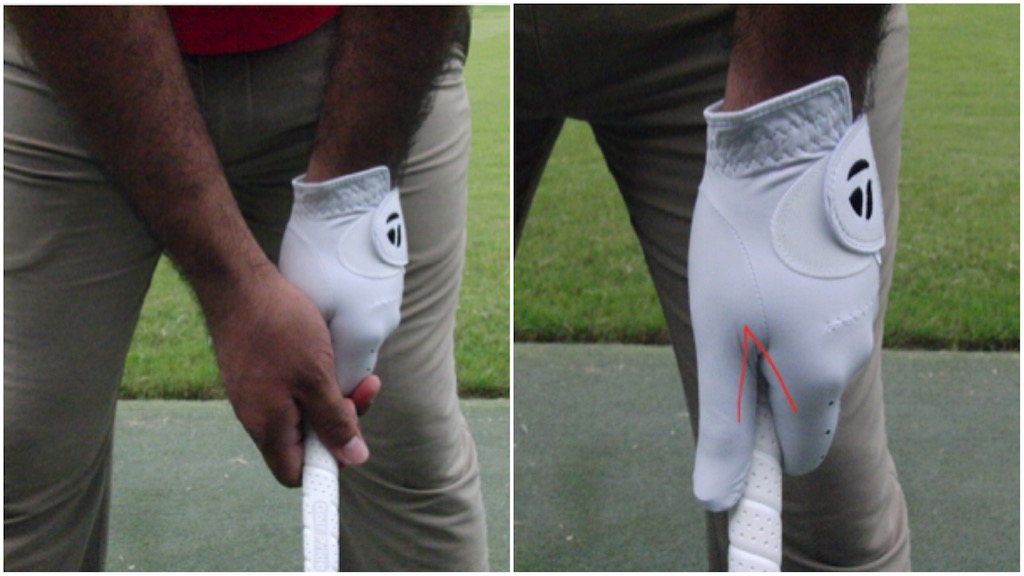
Your grip is the only connection between the club and your body. Thus, ensuring you have a fundamentally sound grip is imperative for you to become the best wedge player possible.
The grip directly influences the club face and its directional position during impact, and as we know, the golf ball begins mostly in the direction of the face at impact. At slower speeds and with higher lofted clubs, the ball will not curve as much, which makes this point even more important if you want to get the ball close to the hole.
The V’s formed between your thumb and forefinger will be used to audit where your grip is positioned. For most players, the V’s should point somewhere between your right ear and right shoulder. Of course, there are exceptions to this fact and you will have to experiment to find your “perfect” grip position.
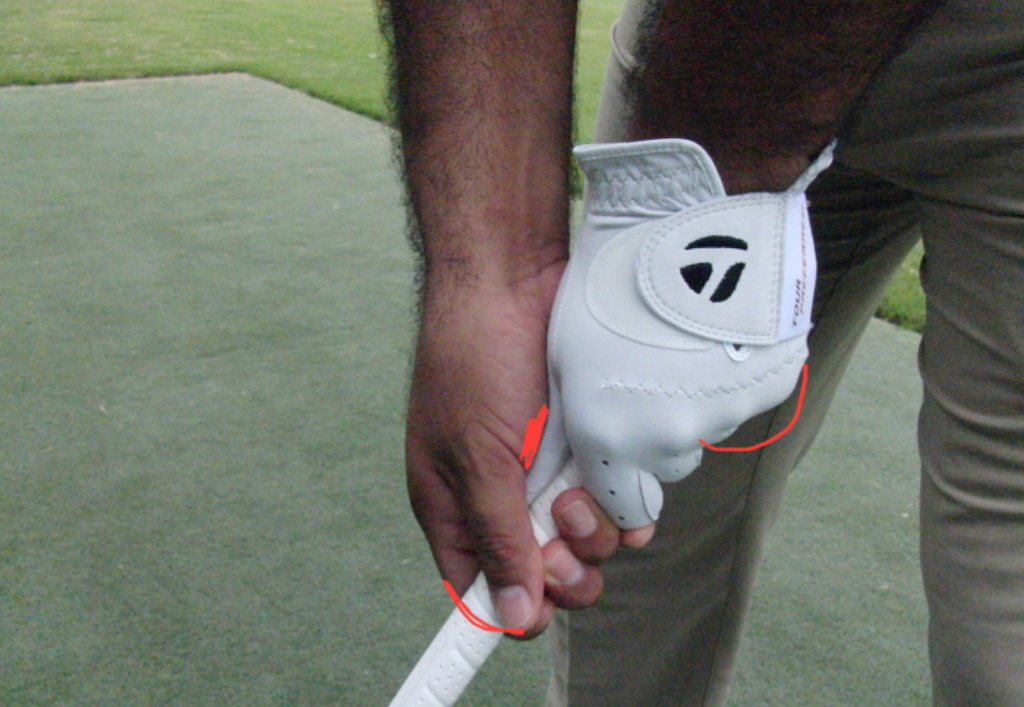
There are also three pressure points to ensure that your grip is solid on the club:
- Where the right thumb pad meets the top of the left thumb
- The last three fingers of the left hand
- The underside of the right index finger
Posture
The posture you establish at address determines where your center of gravity is located and heavily influences the shape of your overall golf swing.
With wedges, there are two things you must ensure at address:
- You are not too close to the ball.
- Your spine is in a centered position.
In the photo below, you can see that the arms hang vertically and the club shaft is pointing at the belt-line, but there is still freedom between the arms and body. If you are too close, or crowd the ball, the club will work too vertically, or steep. If you stand too far away, the club will work too horizontally, or flat. Both of these swing shapes may cause poor wedge play.
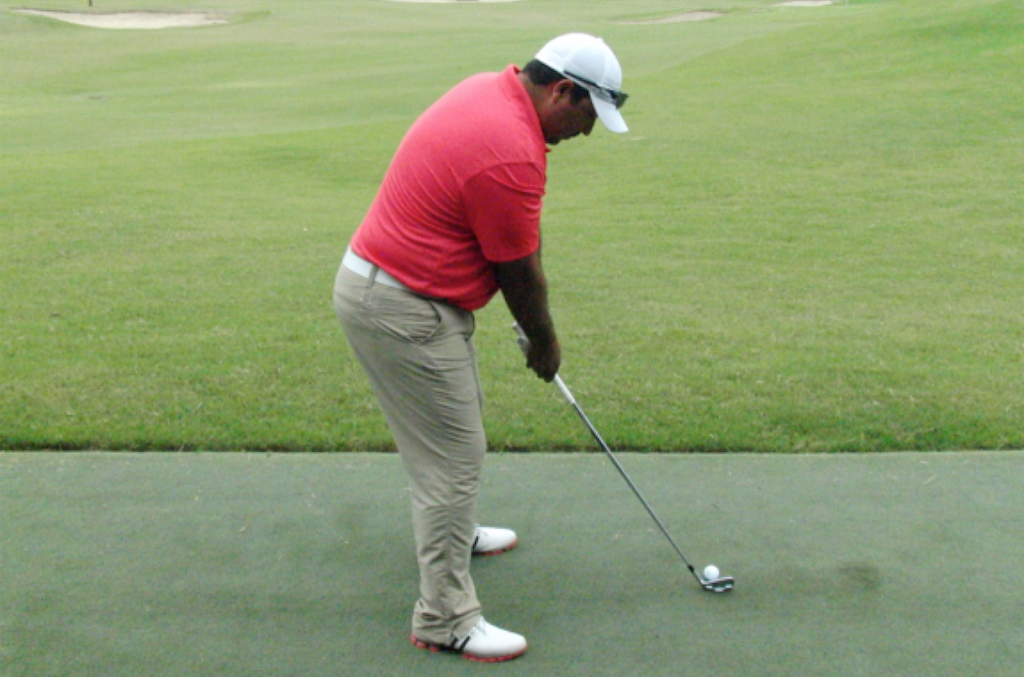
To establish the correct forward bending of your spine, lean forward from the hips with a flat back, allowing the arms to hang down just over the ends of your toes. Your center of gravity should be on the laces of your shoes in this position, as well. To complete this process, set the grip of the club in-line with your belt, and you will have a balanced forward bending of the spine with plenty of freedom to swing the club around your body.
A “Centered” Spine
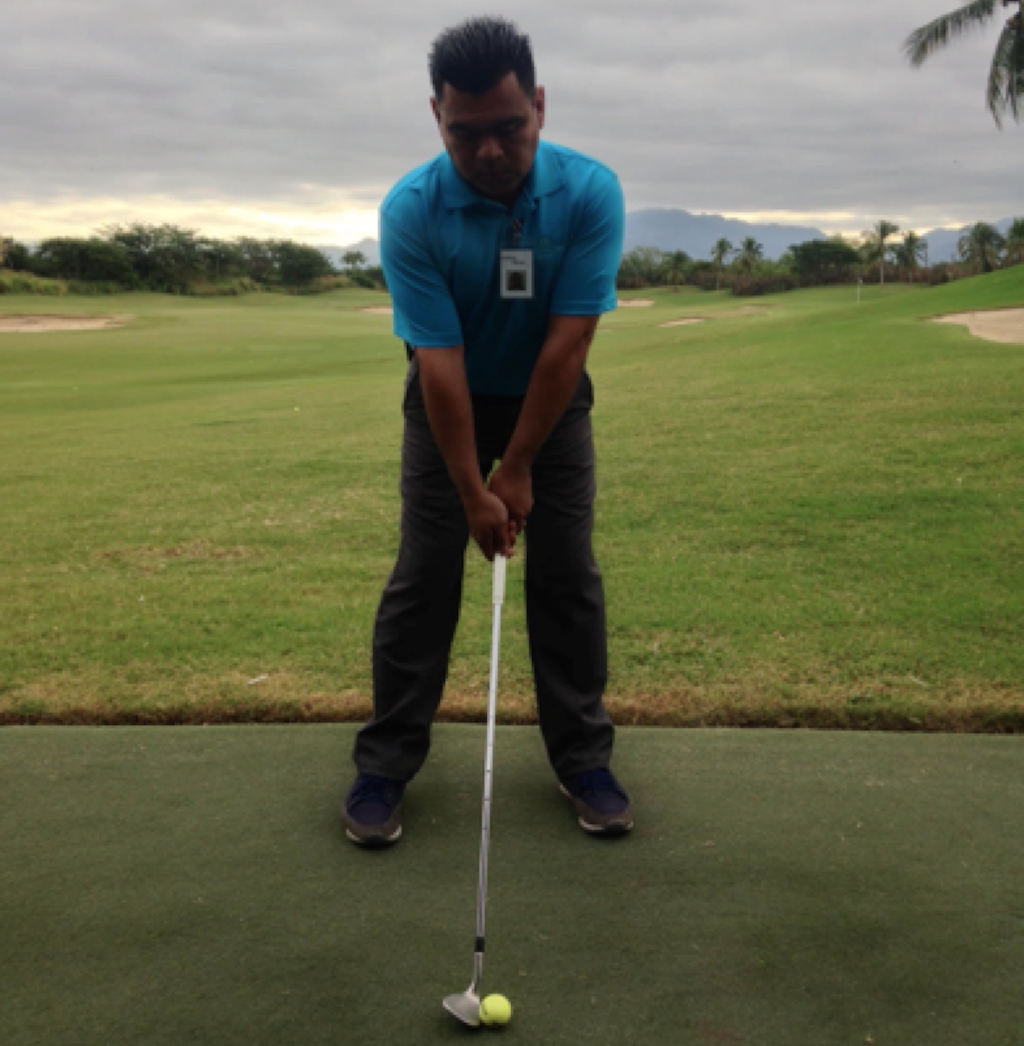
With wedges, unlike most of the other shots, we will preset the spine in a more centered condition to ensure your low point stays in front of the ball during impact.
Stance and Ball Position
Your stance is the foundational “base” that you will swing around, and it’s the launching pad for clubhead speed. The proper stance is one that allows the player to have ample balance coupled with the rotational freedom to move. For most players, the checkpoint is a stance that is around shoulder width.
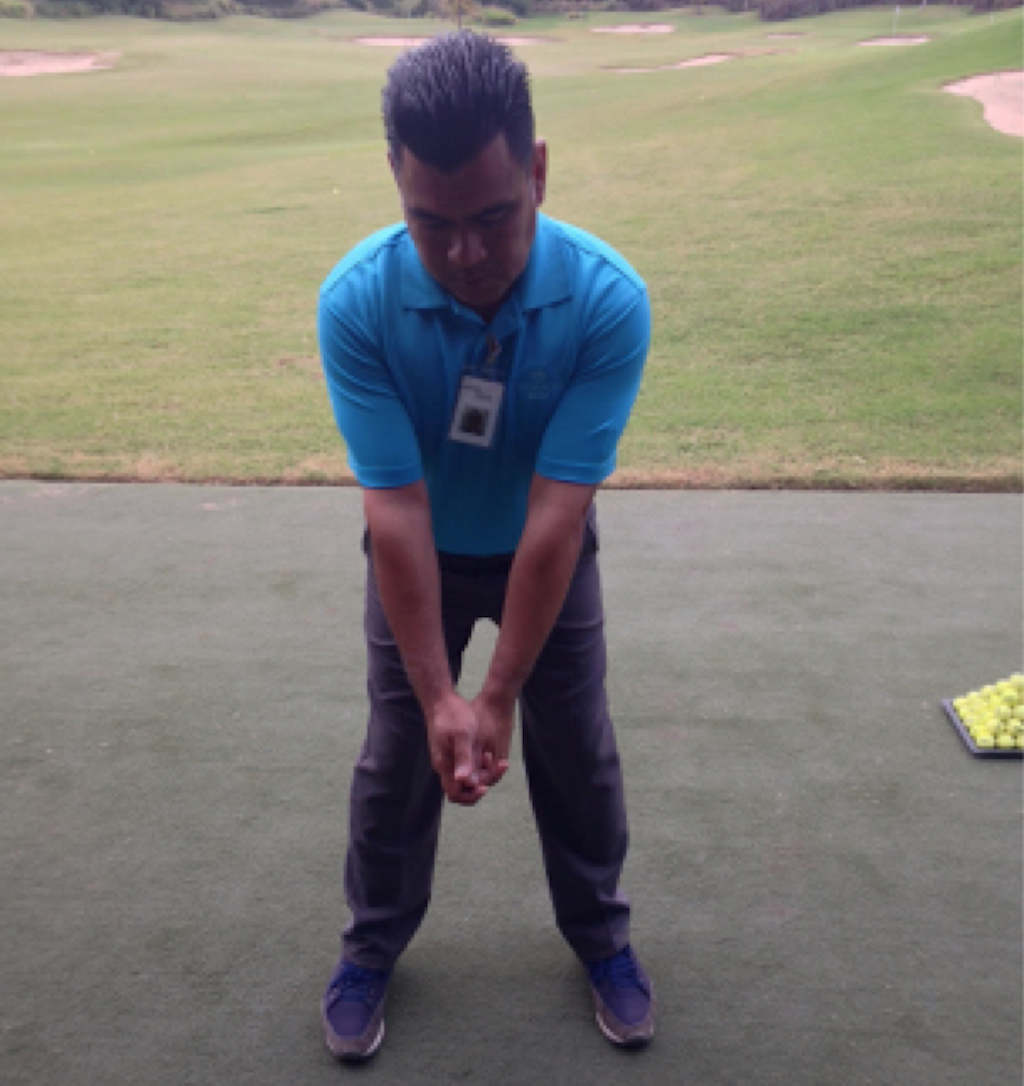
It is our goal with wedge shots to have a stance that allows the player the ability to rotate in a way that ensures a more connected motion back and through. Some players prefer a more narrow stance width on shorter shots. This is OK, but be careful that you don’t inhibit motion in the process.
Ball Position
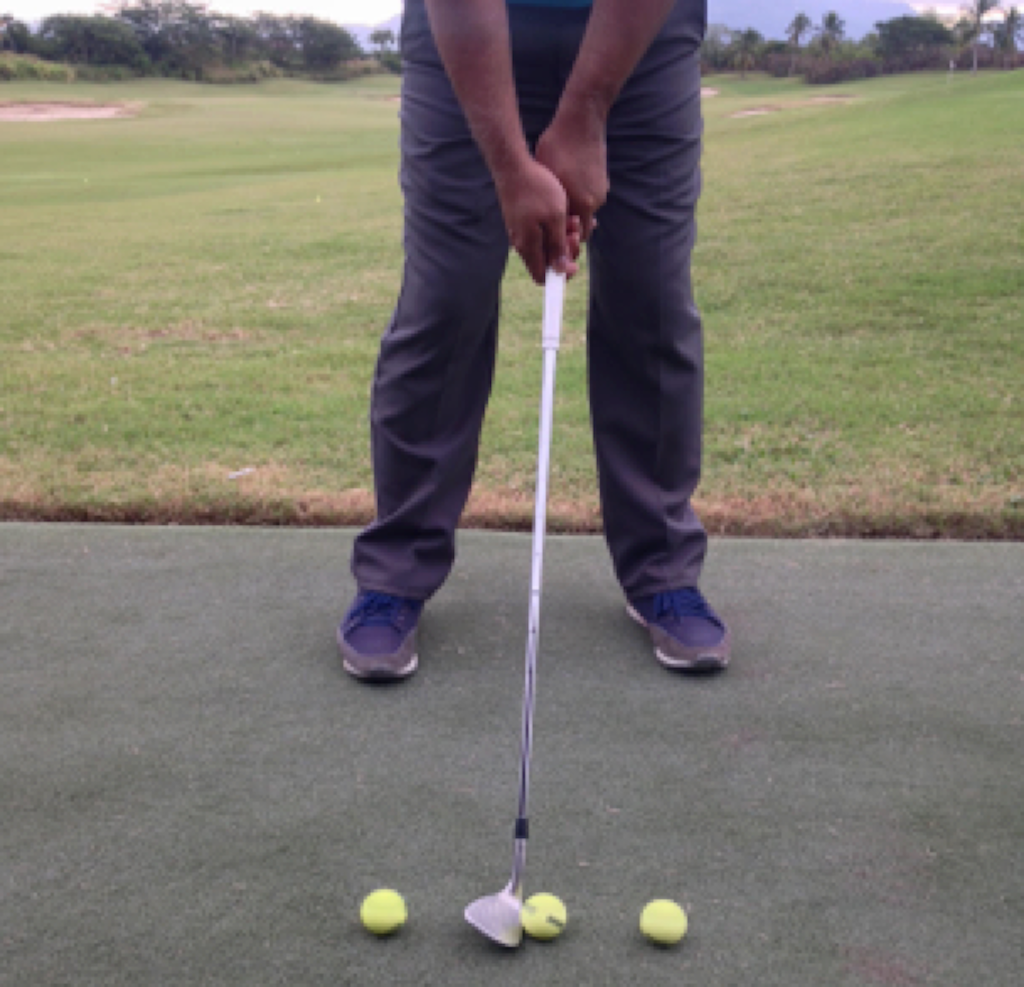
The position of the golf ball between your feet is influenced by the pivot of your body (how you twist, turn, and displace weight), as well as the club you are using.
With wedges, it depends on the shot and the trajectory you desire, however, for 90 percent of the shots you will play you should have the ball in the middle of your stance, just under your sternum. This will encourage a downward blow on the ball, which is what we’re looking for!
Alignment
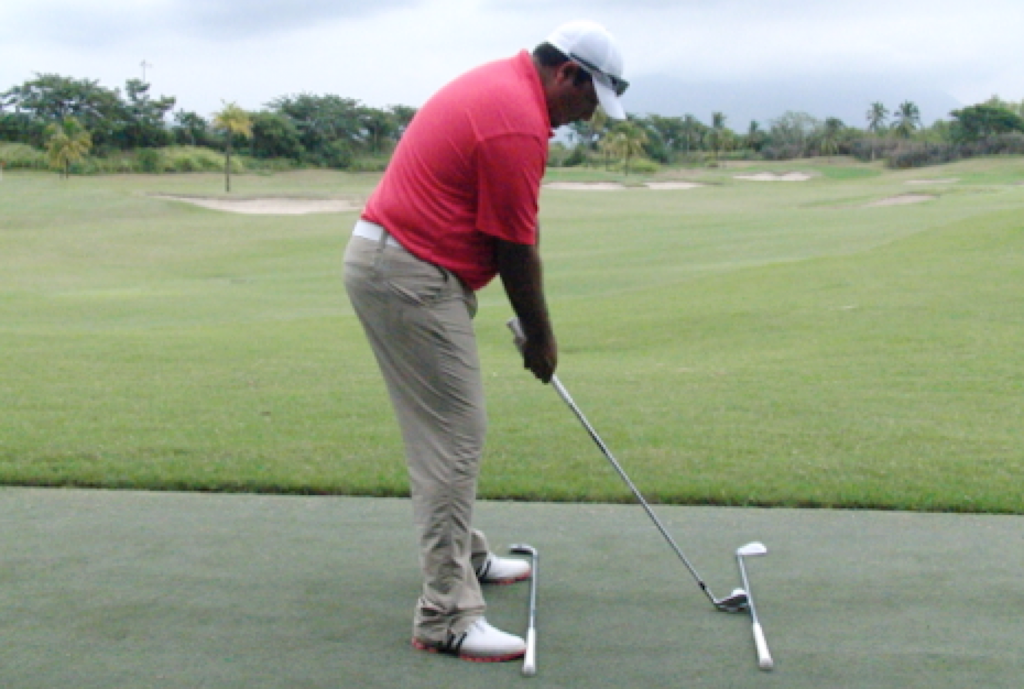
Surely you’ve heard somehwere along your golfing journey that your feet should line up “parallel left” of your target as if you were standing on railroad tracks. As demonstrated in the photo above, your body points along the left rail of the tracks while the clubhead points directly towards the target.
As Trackman Launch Monitor has shown us in recent years, however, this is not entirely correct because when you hit down on a golf ball the swing path is shifted more rightward.
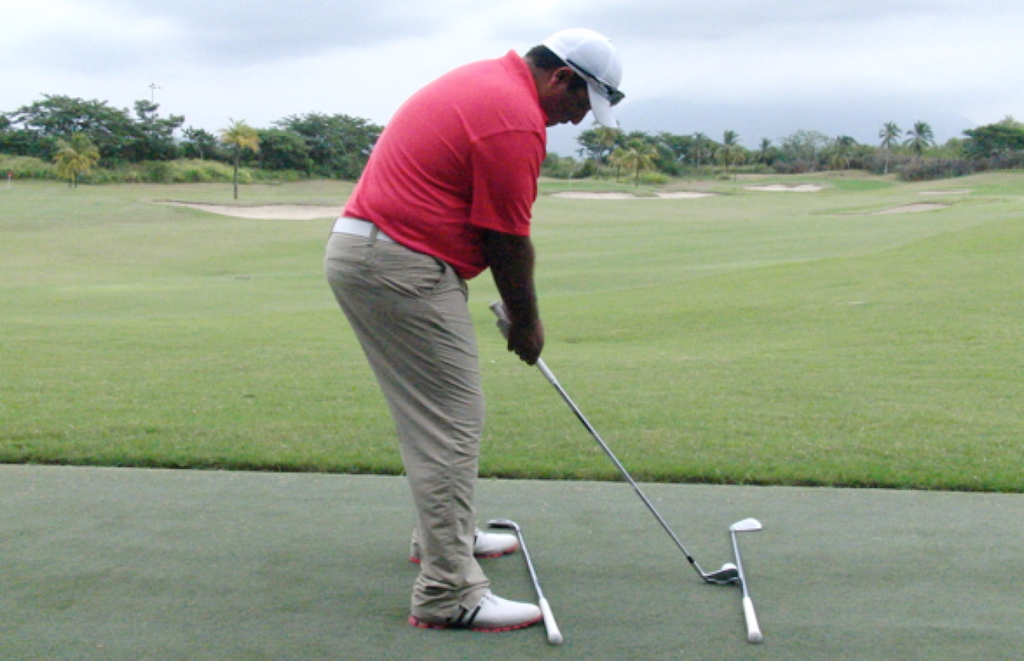
Therefore, when hitting wedges, you must aim a touch more to the left to ensure that your swing path does not shift too far rightward causing you to curve the ball too much from right-to-left.
The Pivot
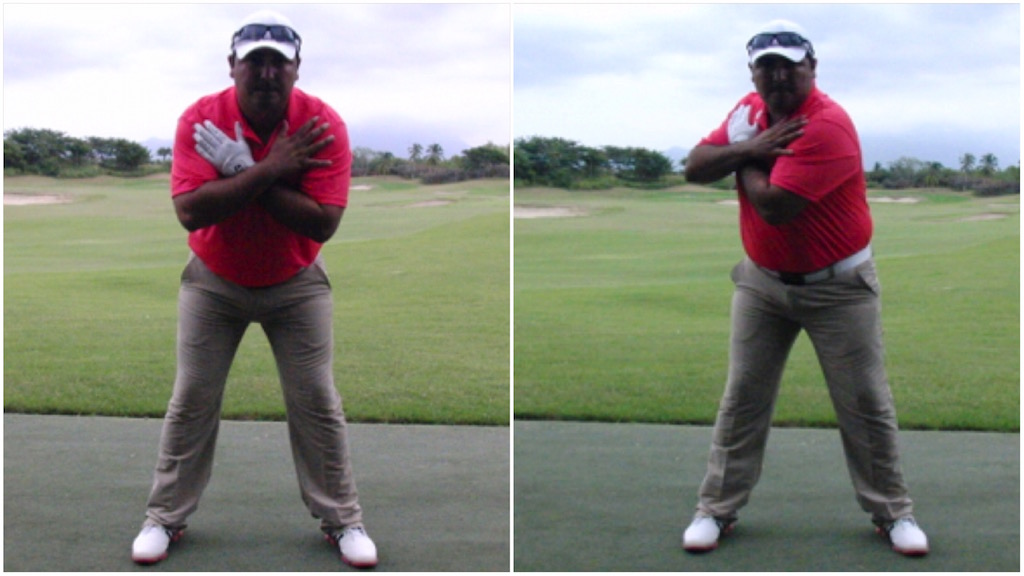
The pivot is simply defined as how your body twists and turns during the swing while displacing weight. Your pivot controls things like rhythm, balance, a steady head, and influences your low point.
When hitting wedges, your weight should stay mostly centered within your feet (as shown below) and on the inside of your rear foot. If the weight moves side-to-side too much while hitting these type of shots, it will be more difficult to impact the golf ball solidly.
In order to understand and feel the pivot, cross your arms and turn your shoulders to the “top” of your backswing while keeping the weight on the inside of you rear foot. Now reverse the process into your “finish” position, keeping the weight on the inside of your forward foot.
As you pivot back and forth, everything should work together back and through so the club, arms and hands, sternum, and zipper all reach the top, impact, and the finish together, thus reducing hand action. The better the pivot, the less you will rely on your arms and hands to drive the club; this will make your low point and release point more reliable under pressure.
Low Point Control
One of the most important things in order to facilitate solid wedge shots is the ability for you to control where the club impacts the ground. The club’s low point must be in front of the golf ball for all shots hit off the ground. If not, you will instantly lose power and consistency.
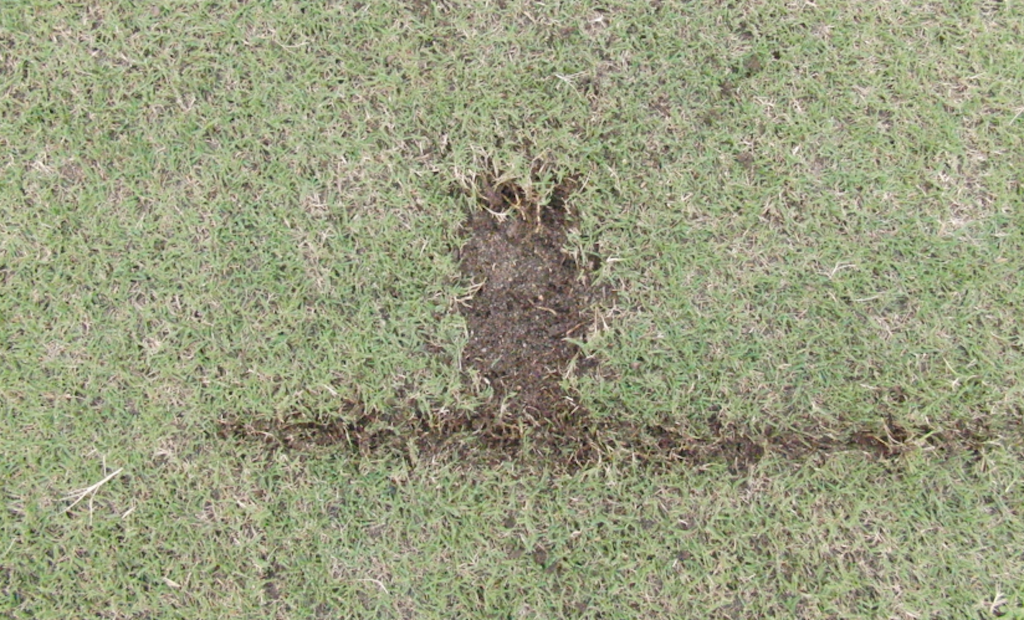
The easiest way to visualize your low point is to draw a line on the ground when you practice. Hit a shot and note where your divot begins. It should always start on the line and forward, never too far in front or behind it.
Face-to-Path
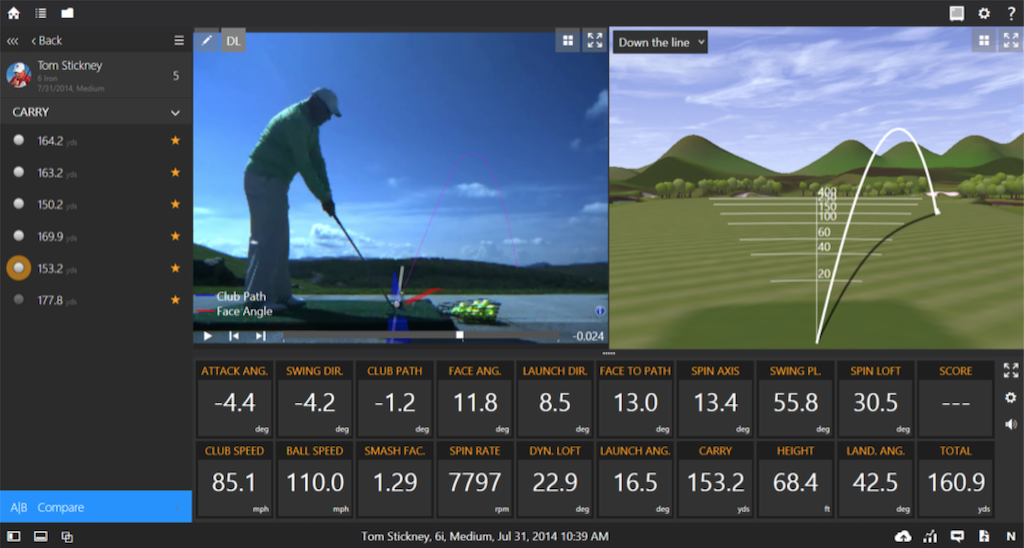
Trackman has also shown us that curvature is created when the face and path diverge, so your face-to-path relationship is very important when hitting wedges. Studies have also shown that the ball begins mostly in the direction of the face and curves away from the path (with a centered hit) as shown above.
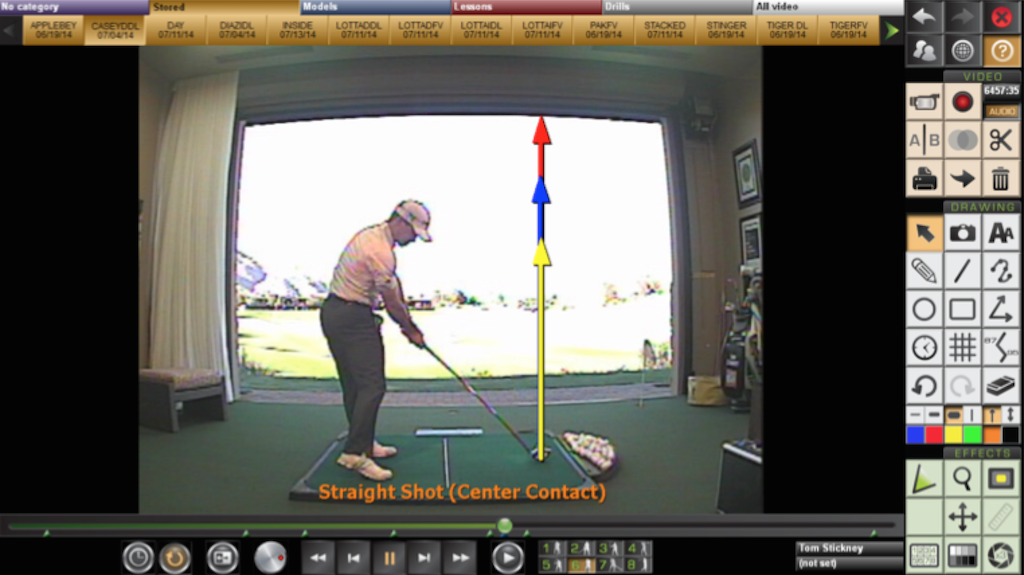
The face is the red arrow (11.8 degrees right of the target) and the path is the blue line (-1.2 degrees left of the target), so the face-to-path relationship in the example above is 13 degrees and the ball curves to the right. Obviously, more loft on the club, coupled with less clubhead speed, causes the ball not to curve as much. But, if you want to hit your wedges as straight as possible, I would suggest you put the following image in your mind: Imagine the path and the face moving in the same “down-the-line” direction at impact. If you diminish the amount of face-to-path dispersion, you WILL hit the ball straighter than you ever have with the wedges.
Lastly, enjoy the process of becoming a better wedge player. Remember, the more often you practice, work on your fundamentals, and develop your feel around the green, the more strokes you will save and the lower you will score. Enjoy the journey!
- LIKE94
- LEGIT17
- WOW3
- LOL7
- IDHT3
- FLOP6
- OB0
- SHANK30
Instruction
The Wedge Guy: The easiest-to-learn golf basic

My golf learning began with this simple fact – if you don’t have a fundamentally sound hold on the golf club, it is practically impossible for your body to execute a fundamentally sound golf swing. I’m still a big believer that the golf swing is much easier to execute if you begin with the proper hold on the club.
As you might imagine, I come into contact with hundreds of golfers of all skill levels. And it is very rare to see a good player with a bad hold on the golf club. There are some exceptions, for sure, but they are very few and very far between, and they typically have beat so many balls with their poor grip that they’ve found a way to work around it.
The reality of biophysics is that the body moves only in certain ways – and the particulars of the way you hold the golf club can totally prevent a sound swing motion that allows the club to release properly through the impact zone. The wonderful thing is that anyone can learn how to put a fundamentally sound hold on the golf club, and you can practice it anywhere your hands are not otherwise engaged, like watching TV or just sitting and relaxing.
Whether you prefer an overlap, interlock or full-finger (not baseball!) grip on the club, the same fundamentals apply. Here are the major grip faults I see most often, in the order of the frequency:
Mis-aligned hands
By this I mean that the palms of the two hands are not parallel to each other. Too many golfers have a weak left hand and strong right, or vice versa. The easiest way to learn how to hold the club with your palms aligned properly is to grip a plain wooden ruler or yardstick. It forces the hands to align properly and shows you how that feels. If you grip and re-grip a yardstick several times, then grip a club, you’ll see that the learning curve is almost immediate.
The position of the grip in the upper/left hand
I also observe many golfers who have the butt of the grip too far into the heel pad of the upper hand (the left hand for right-handed players). It’s amazing how much easier it is to release the club through the ball if even 1/4-1/2″ of the butt is beyond the left heel pad. Try this yourself to see what I mean. Swing the club freely with just your left hand and notice the difference in its release from when you hold it at the end of the grip, versus gripping down even a half inch.
To help you really understand how this works, go to the range and hit shots with your five-iron gripped down a full inch to make the club the same length as your seven-iron. You will probably see an amazing shot shape difference, and likely not see as much distance loss as you would expect.
Too much lower (right) hand on the club
It seems like almost all golfers of 8-10 handicap or higher have the club too far into the palm of the lower hand, because that feels “good” if you are trying to control the path of the clubhead to the ball. But the golf swing is not an effort to hit at the ball – it is a swing of the club. The proper hold on the club has the grip underneath the pad at the base of the fingers. This will likely feel “weak” to you — like you cannot control the club like that. EXACTLY. You should not be trying to control the club with your lower/master hand.
Gripping too tightly
Nearly all golfers hold the club too tightly, which tenses up the forearms and prevents a proper release of the club through impact. In order for the club to move back and through properly, you must feel that the club is controlled by the last three fingers of the upper hand, and the middle two fingers of the lower hand. If you engage your thumbs and forefingers in “holding” the club, the result will almost always be a grip that is too tight. Try this for yourself. Hold the club in your upper hand only, and squeeze firmly with just the last three fingers, with the forefinger and thumb off the club entirely. You have good control, but your forearms are not tense. Then begin to squeeze down with your thumb and forefinger and observe the tensing of the entire forearm. This is the way we are made, so the key to preventing tenseness in the arms is to hold the club very lightly with the “pinchers” — the thumbs and forefingers.
So, those are what I believe are the four fundamentals of a good grip. Anyone can learn them in their home or office very quickly. There is no easier way to improve your ball striking consistency and add distance than giving more attention to the way you hold the golf club.
More from the Wedge Guy
- The Wedge Guy: Golf mastery begins with your wedge game
- The Wedge Guy: Why golf is 20 times harder than brain surgery
- The Wedge Guy: Musings on the golf ball rollback
- LIKE86
- LEGIT13
- WOW6
- LOL1
- IDHT0
- FLOP4
- OB1
- SHANK8
Instruction
Clement: Stop ripping off your swing with this drill!

Not the dreaded headcover under the armpit drill! As if your body is defective and can’t function by itself! Have you seen how incredible the human machine is with all the incredible feats of agility all kinds of athletes are accomplishing? You think your body is so defective (the good Lord is laughing his head off at you) that it needs a headcover tucked under the armpit so you can swing like T-Rex?
- LIKE0
- LEGIT2
- WOW2
- LOL0
- IDHT0
- FLOP0
- OB0
- SHANK2
Instruction
How a towel can fix your golf swing

This is a classic drill that has been used for decades. However, the world of marketed training aids has grown so much during that time that this simple practice has been virtually forgotten. Because why teach people how to play golf using everyday items when you can create and sell a product that reinforces the same thing? Nevertheless, I am here to give you helpful advice without running to the nearest Edwin Watts or adding something to your Amazon cart.
For the “scoring clubs,” having a solid connection between the arms and body during the swing, especially through impact, is paramount to creating long-lasting consistency. And keeping that connection throughout the swing helps rotate the shoulders more to generate more power to help you hit it farther. So, how does this drill work, and what will your game benefit from it? Well, let’s get into it.
Setup
You can use this for basic chip shots up to complete swings. I use this with every club in my bag, up to a 9 or 8-iron. It’s natural to create incrementally more separation between the arms and body as you progress up the set. So doing this with a high iron or a wood is not recommended.
While you set up to hit a ball, simply tuck the towel underneath both armpits. The length of the towel will determine how tight it will be across your chest but don’t make it so loose that it gets in the way of your vision. After both sides are tucked, make some focused swings, keeping both arms firmly connected to the body during the backswing and follow through. (Note: It’s normal to lose connection on your lead arm during your finishing pose.) When you’re ready, put a ball in the way of those swings and get to work.

Get a Better Shoulder Turn
Many of us struggle to have proper shoulder rotation in our golf swing, especially during long layoffs. Making a swing that is all arms and no shoulders is a surefire way to have less control with wedges and less distance with full swings. Notice how I can get in a similar-looking position in both 60° wedge photos. However, one is weak and uncontrollable, while the other is strong and connected. One allows me to use my larger muscles to create my swing, and one doesn’t. The follow-through is another critical point where having a good connection, as well as solid shoulder rotation, is a must. This drill is great for those who tend to have a “chicken wing” form in their lead arm, which happens when it becomes separated from the body through impact.
In full swings, getting your shoulders to rotate in your golf swing is a great way to reinforce proper weight distribution. If your swing is all arms, it’s much harder to get your weight to naturally shift to the inside part of your trail foot in the backswing. Sure, you could make the mistake of “sliding” to get weight on your back foot, but that doesn’t fix the issue. You must turn into your trial leg to generate power. Additionally, look at the difference in separation between my hands and my head in the 8-iron examples. The green picture has more separation and has my hands lower. This will help me lessen my angle of attack and make it easier to hit the inside part of the golf ball, rather than the over-the-top move that the other picture produces.


Stay Better Connected in the Backswing
When you don’t keep everything in your upper body working as one, getting to a good spot at the top of your swing is very hard to do. It would take impeccable timing along with great hand-eye coordination to hit quality shots with any sort of regularity if the arms are working separately from the body.
Notice in the red pictures of both my 60-degree wedge and 8-iron how high my hands are and the fact you can clearly see my shoulder through the gap in my arms. That has happened because the right arm, just above my elbow, has become totally disconnected from my body. That separation causes me to lift my hands as well as lose some of the extension in my left arm. This has been corrected in the green pictures by using this drill to reinforce that connection. It will also make you focus on keeping the lead arm close to your body as well. Because the moment either one loses that relationship, the towel falls.


Conclusion
I have been diligent this year in finding a few drills that target some of the issues that plague my golf game; either by simply forgetting fundamental things or by coming to terms with the faults that have bitten me my whole career. I have found that having a few drills to fall back on to reinforce certain feelings helps me find my game a little easier, and the “towel drill” is most definitely one of them.
- LIKE12
- LEGIT2
- WOW2
- LOL0
- IDHT0
- FLOP2
- OB0
- SHANK8
-

 19th Hole2 weeks ago
19th Hole2 weeks agoDave Portnoy places monstrous outright bet for the 2024 Masters
-

 19th Hole2 weeks ago
19th Hole2 weeks agoTiger Woods arrives at 2024 Masters equipped with a putter that may surprise you
-

 19th Hole1 day ago
19th Hole1 day ago‘Absolutely crazy’ – Major champ lays into Patrick Cantlay over his decision on final hole of RBC Heritage
-

 19th Hole3 weeks ago
19th Hole3 weeks agoReport: Tiger Woods has ‘eliminated sex’ in preparation for the 2024 Masters
-

 19th Hole1 week ago
19th Hole1 week agoTwo star names reportedly blanked Jon Rahm all week at the Masters
-

 19th Hole1 week ago
19th Hole1 week agoReport: LIV Golf identifies latest star name they hope to sign to breakaway tour
-

 19th Hole1 week ago
19th Hole1 week agoNeal Shipley presser ends in awkward fashion after reporter claims Tiger handed him note on 8th fairway
-

 19th Hole1 day ago
19th Hole1 day agoJustin Thomas on the equipment choice of Scottie Scheffler that he thinks is ‘weird’















Dave R
Aug 8, 2017 at 12:35 pm
So do you replace all your divots and repair all your ball marks. Why do you loose golf balls your short game is like a touring pro?
Matt
Aug 8, 2017 at 5:21 am
Hi Tom, great info. Just wanted to add, as a very average golfer with limited time to play, etc, that knowing a range of wedge distances is also really valuable information to have. I noted wedge distances recently using Pelz’ system (for each wedge loft in my bag using 7:30, 9:00 and 10:30 backswings) and have noticed a big improvement in my scores.
Ude
Aug 7, 2017 at 5:25 pm
and you don’t play golf …. sooo obvious
Bob Jones
Aug 7, 2017 at 11:48 am
Low point control is the part of pitching that doesn’t get talked about much, but is as important as anything else for controlling distance. During a playing lesson, my practice swings for an ~80 yard pitch were all clearly of different depths, and the pro told me right away I had to correct that if I wanted to master this shot.
Chris
Aug 5, 2017 at 11:53 pm
I find this to be fairly sound, basic advice. However, I wish more instructors would also discuss the alignment of the forearms, elbows, and upper arms in the setup as well. You can have a technically sound grip, but misalign those parts and suffer with inconsistent face and path conditions. With wedge practice, those inconsistencies may not become as evident without a launch monitor, and bleed into and influence a full swing, to the players detriment.